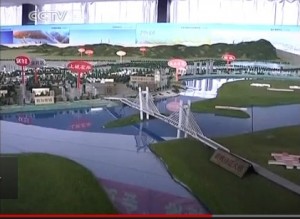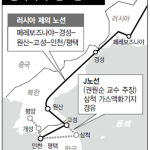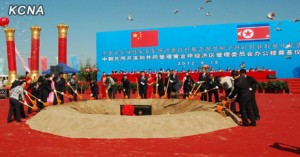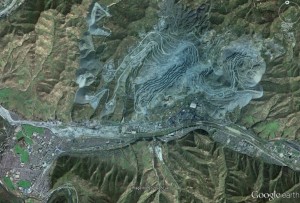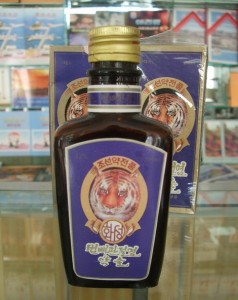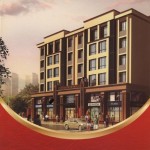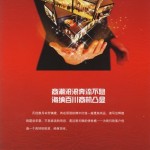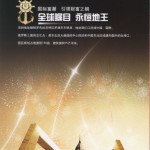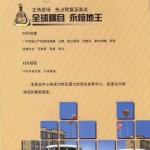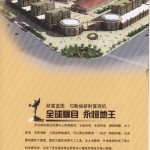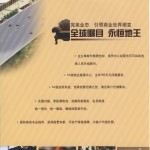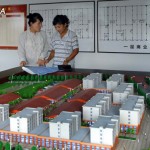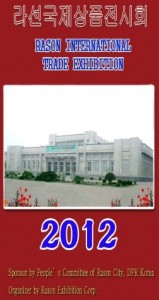UPDATE 5 (2012-11-7): The China Daily’s English-language Dandong page offers additional details of the expo:
Despite the global economic slowdown, more than 6,000 business representatives from 20 countries signed agreements on more than 200 cooperative projects. Some 72 of the largest projects have a total combined value of $1.26 billion.
…
During the 11th Five-Year Plan period (2006-2010), total trade value between Dandong and DPRK amounted to $3 billion. Imports and exports between Dandong and the DPRK reached $1.86 billion in 2011.
So far, trade between Dandong and DPRK accounts for 40 percent of total China-DPRK trade, and the volume of the cross-border cargo trade via Dandong port makes up 80 percent of the total Sino-DPRK trade volume.
UPDATE 4 (2012-10-16): Xinhua reports on the closing of the expo:
The five-day 2012 China-DPRK Economic, Trade, Culture and Tourism Expo, held in the border city of Dandong, concluded on Tuesday with 72 agreements of cooperation intent signed. They have a combined value of 1.26 billion US dollars.
Pan Shuang, vice mayor of Dandong, said more than 6,000 Chinese and overseas people from over 20 countries and regions exhibited at and attended the expo. There were talks on 200 projects.
He said the projects related to industries ranging from aquaculture, clothes manufacturing, chemical production, wind power generation equipment, iron steel production to hotel construction.
AT THE EXPO
At the exhibition, the DPRK delegation exhibited ginseng products, food specialties, hand-made Hanbok, a traditional Korean costume, as well as mining and machinery equipment.
Ri Yong Chol, sales manager of Korea Roksan General Trading Corp., which is a ginseng supplier, said “I came to look for Chinese friends and potential business partners. Our company is also seeking opportunities to set up a subsidiary in China to get better access to the Chinese market.”
A Korean girl wearing brightly-colored Hanbok and traditional ornaments was selling costumes. “Our factory can make 20 such hand-made Hanboks a day. The clothes are for important occasions with exquisite workmanship and high-quality material,” she said.
Liu Songyu, chairman of a Korean garment firm from Yanbian Korean Autonomous Prefecture of Jilin Province, was interested in the business.
“Chinese labor costs have been rising fast. In Yanbian, a garment-factory worker’s salary has risen to 2,000 yuan (319 US dollars) a month. While, if the company had a factory in DPRK, it would save a considerable amount on labor costs. I would give a serious thought to that,” he said.
Yanbian is a heavily Korean ethnic populated region in China, where people also wear Hanbok during important occasions.
Elsewhere, Huang Zijun, an authorized dealer of Total Petrochemcial, was overwhelmed to obtain 20 orders from the DPRK delegation during the expo.
“I felt their enthusiasm in promoting business at the expo. I believe the DPRK is a big market for petrochemical products like lubricating oil,” he said.
Here is coverage of the closing in the Daily NK.
UPDATE 3 (2012-10-14): Martyn Williams pointed out this video to me which readers may also find interesting:
Click image to see video at CCTV web page
UPDATE 2 (2012-10-14): According to Xinhua:
An economic, trade, culture and tourism expo jointly initiated by China and the Democratic People’s Republic of Korea (DPRK) opened Friday in the border city of Dandong in northeast China’s Liaoning Province.
A delegation of 500 members from the DPRK is attending the 2012 China-DPRK Economic, Trade, Culture and Tourism Expo, which is scheduled to run from Friday to Tuesday, the event’s organizers said.
Over 400 Chinese companies from 12 industries are also attending the expo.
With the theme of “friendship, cooperation and development,” the expo consists of commodity exhibitions, trade fairs, DPRK art performances, craftwork exhibitions, a border trip to the Yalu River and an exhibition for the tourism resources of the two countries.
Supported by the China Council for the Promotion of International Trade, the event is being organized by the Liaoning Provincial Government.
China is DPRK’s biggest trade partner. Statistics show that bilateral trade volume went up 62.4 percent year on year to 5.64 billion U.S. dollars last year.
Xinhua posted these official photos.
CCTV also covered the expo. Here is their English-language report:
Here is KCNA coverage of the expo:
The Daily NK also reported on the expo:
A source from Dandong described the unusually vibrant scene to Daily NK yesterday, saying, “The North Korean authorities have mobilized companies from Pyongyang and from here in China to sell goods and pitch for joint venture opportunities. There are loads of people; it’s standing room only.”
The source added that North Korean companies attending the event are pushing very hard to attract investment; notably, by distributing their own promotional literature expounding upon the given company’s superior virtues and providing exact contact details for follow-up inquiries. It is not hard to find meetings continuing in local North Korean eateries, as the North Korean side tries to woo potential sources of capital.
Chinese companies are keen to hear about the joint venture opportunities available, the source also said; and with most of the larger enterprises from China’s three northeastern provinces sending representatives to Dandong for the event, which runs until the 16th, most of the city’s hotels are apparently full to bursting.
However, due to past and present cases of lip service being paid to contractual obligations by North Korean companies whose only goal has been to attract funding rather than build business, Chinese representatives are still very cautious about actually signing on the dotted line.
One such representative from a Dandong-based company with a 10-year history of doing business with North Korea pointed out to Daily NK, “We have seen countless examples of companies making contracts and then there being little contact between the partners thereafter. Unbelievably, one manager I tried some minerals business with last year just changed the name of the company and came back again this year.”
Additional Information:
1. Here is IFES coverage of the expo.
2. The DPRK also held investment seminars back in late September.
UPDATE 1 (2012-6-7): The expo appears to have been pushed back to October 2012. According to KBS:
North Korea and China will jointly hold a fair on economy, trade, culture and tourism in the Chinese border city of Dandong for five days from October 12th.
A Dandong-based newspaper reports that this will be the first comprehensive fair covering several fields that the two countries hold. The paper said the fair will exhibit products, offer trade consultations, hold cultural and art performances and introduce both nations’ tourist attractions.
Roughly 400 Chinese companies exporting to North Korea will participate in the event. About 100 North Korean companies and cultural troupes will partake.
Dandong is China’s largest base for trade with North Korea, with 70 percent of its trade with North Korea running through the border city.
Read the full story here:
N.Korea, China to Hold Joint Industrial Fair in October
KBS
2012-6-7
ORIGINAL POST (2011-12-3): Dandong to host Sino-DPRK economic and cultural expo. According to Xinhua:
The northeastern Chinese city of Dandong, which borders the Democratic People’s Republic of Korea (DPRK), will host a Sino-DPRK economic, trade and cultural exposition in June next year, a local Chinese official said Saturday.
A series of activities, including a commodity fair, investment and trade talks, tourism exhibition and arts exhibition, will be staged during the exposition, said a spokesman with the Publicity Department of the Dandong Municipal Committee of the Communist Party of China.
The Phibada Opera Troupe of the DPRK, an artists group well known to Chinese people, will give performances during the event, he said.
Adam Cathcart took the time to send me this interesting link to the official Dandong web page. It contains some videos (in Chinese) in which local officials promote the changes they expect to come to this city as it transitions into a regional trade hub.
Below I have added some links to recent blog posts that a re related to Dandong:
1. Dandong customs house is busy, busy, busy (2011-9-13)
2. Chinese foreign ministry publication frank on Rason and Hwanggumphyong (2011-8-31)
3. New Yalu River bridge in south-west Dandong (2011-6-25)
4. Some alleged guidelines for the Hwanggumphyong SEZ (2011-6-24)
5. DPRK and PRC launch joint Yalu patrols (2011-6-15)
6. Sinuiju SEZ Version 5: Hwanggumphyong-ri and Wihwa Island (2011-6-14)
7. Dandong-DPRK trade and growth (2010-12-2)
8. Future Sinuiju development affecting Dandong today (2010-10-19)
9. DPRK-China trade and investment growing (2010-10-1)
10. Dandong launches DPRK trade program (2010-8-19)
